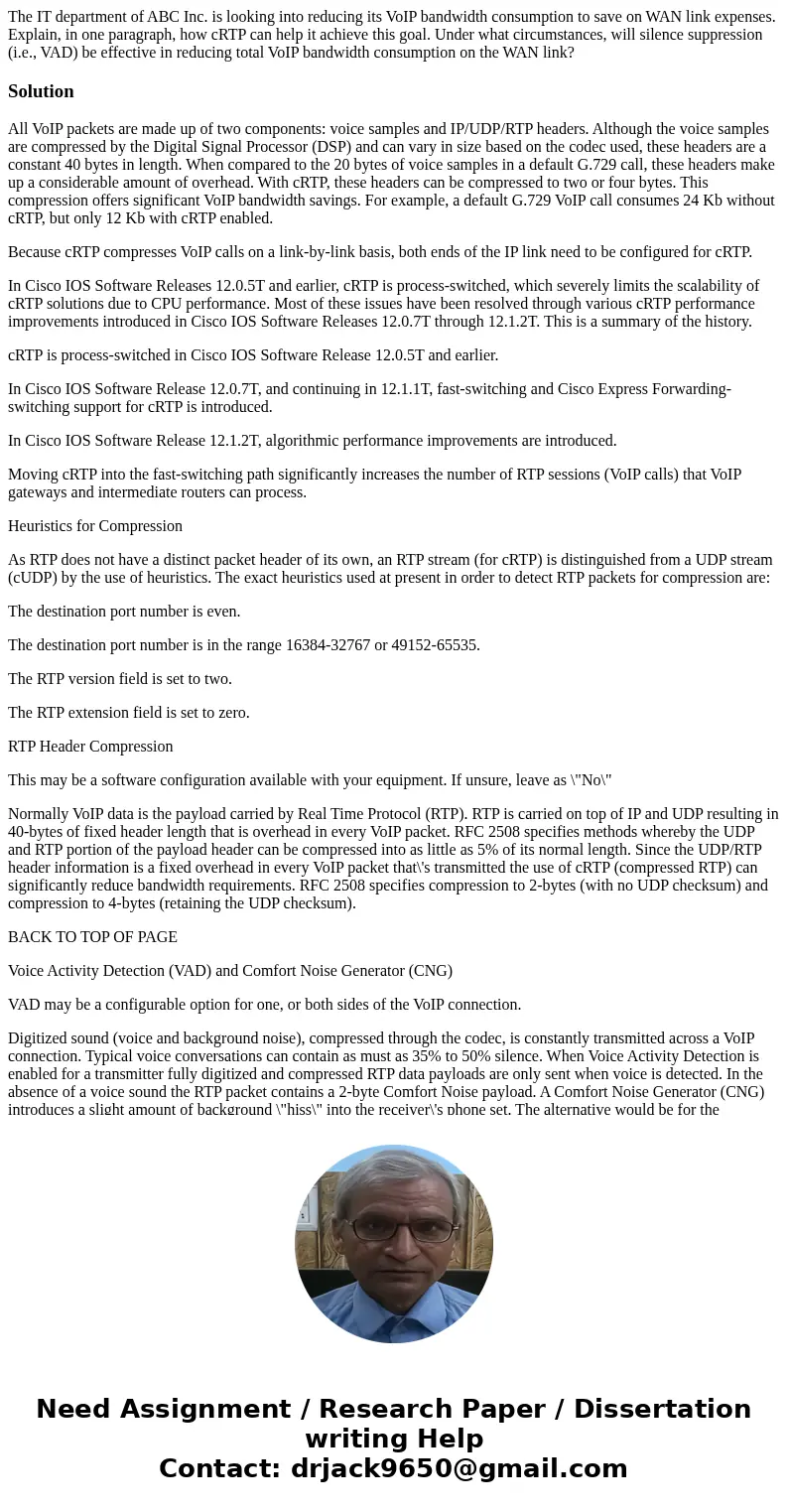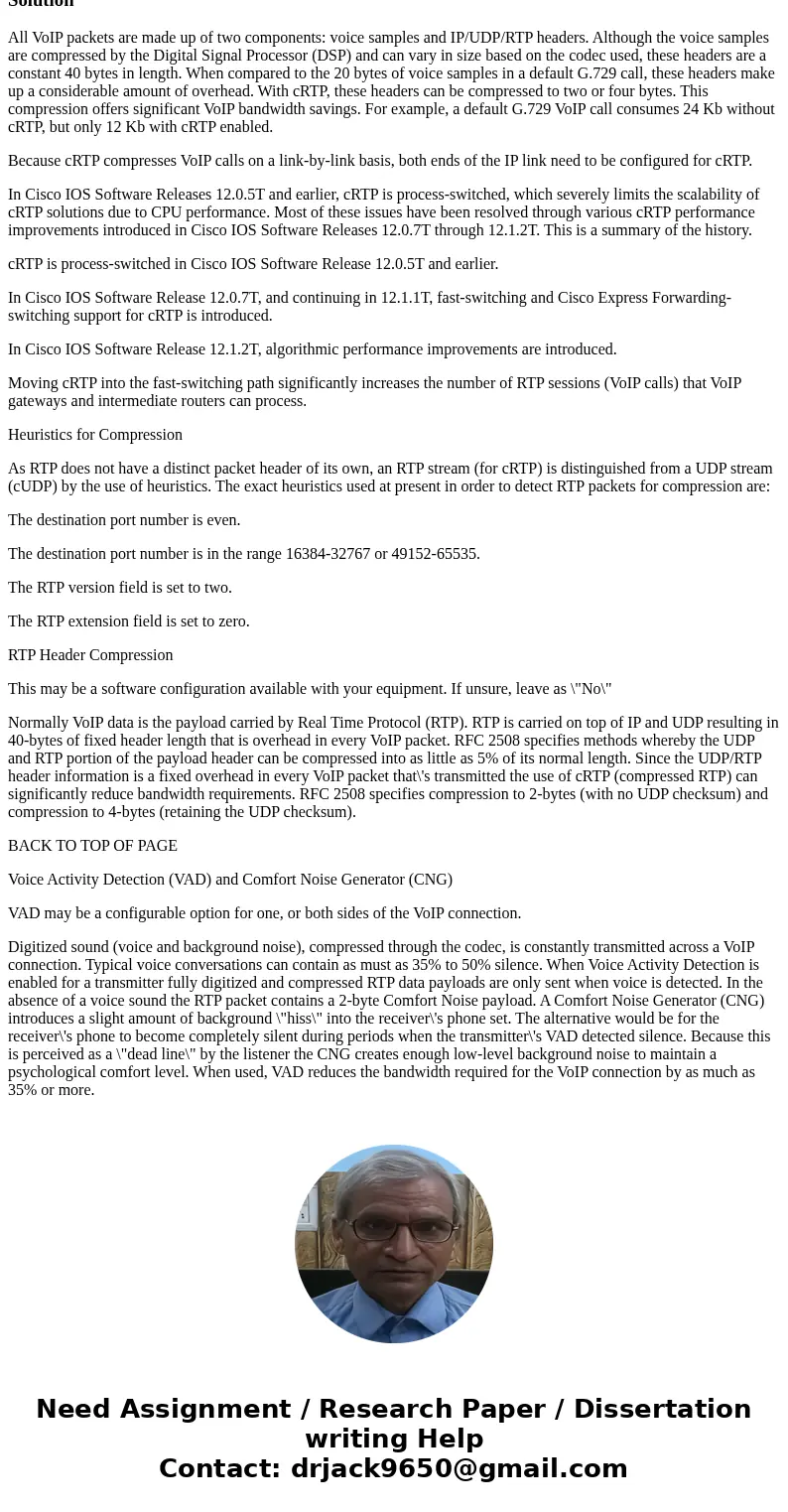The IT department of ABC Inc is looking into reducing its Vo
The IT department of ABC Inc. is looking into reducing its VoIP bandwidth consumption to save on WAN link expenses. Explain, in one paragraph, how cRTP can help it achieve this goal. Under what circumstances, will silence suppression (i.e., VAD) be effective in reducing total VoIP bandwidth consumption on the WAN link?
Solution
All VoIP packets are made up of two components: voice samples and IP/UDP/RTP headers. Although the voice samples are compressed by the Digital Signal Processor (DSP) and can vary in size based on the codec used, these headers are a constant 40 bytes in length. When compared to the 20 bytes of voice samples in a default G.729 call, these headers make up a considerable amount of overhead. With cRTP, these headers can be compressed to two or four bytes. This compression offers significant VoIP bandwidth savings. For example, a default G.729 VoIP call consumes 24 Kb without cRTP, but only 12 Kb with cRTP enabled.
Because cRTP compresses VoIP calls on a link-by-link basis, both ends of the IP link need to be configured for cRTP.
In Cisco IOS Software Releases 12.0.5T and earlier, cRTP is process-switched, which severely limits the scalability of cRTP solutions due to CPU performance. Most of these issues have been resolved through various cRTP performance improvements introduced in Cisco IOS Software Releases 12.0.7T through 12.1.2T. This is a summary of the history.
cRTP is process-switched in Cisco IOS Software Release 12.0.5T and earlier.
In Cisco IOS Software Release 12.0.7T, and continuing in 12.1.1T, fast-switching and Cisco Express Forwarding-switching support for cRTP is introduced.
In Cisco IOS Software Release 12.1.2T, algorithmic performance improvements are introduced.
Moving cRTP into the fast-switching path significantly increases the number of RTP sessions (VoIP calls) that VoIP gateways and intermediate routers can process.
Heuristics for Compression
As RTP does not have a distinct packet header of its own, an RTP stream (for cRTP) is distinguished from a UDP stream (cUDP) by the use of heuristics. The exact heuristics used at present in order to detect RTP packets for compression are:
The destination port number is even.
The destination port number is in the range 16384-32767 or 49152-65535.
The RTP version field is set to two.
The RTP extension field is set to zero.
RTP Header Compression
This may be a software configuration available with your equipment. If unsure, leave as \"No\"
Normally VoIP data is the payload carried by Real Time Protocol (RTP). RTP is carried on top of IP and UDP resulting in 40-bytes of fixed header length that is overhead in every VoIP packet. RFC 2508 specifies methods whereby the UDP and RTP portion of the payload header can be compressed into as little as 5% of its normal length. Since the UDP/RTP header information is a fixed overhead in every VoIP packet that\'s transmitted the use of cRTP (compressed RTP) can significantly reduce bandwidth requirements. RFC 2508 specifies compression to 2-bytes (with no UDP checksum) and compression to 4-bytes (retaining the UDP checksum).
BACK TO TOP OF PAGE
Voice Activity Detection (VAD) and Comfort Noise Generator (CNG)
VAD may be a configurable option for one, or both sides of the VoIP connection.
Digitized sound (voice and background noise), compressed through the codec, is constantly transmitted across a VoIP connection. Typical voice conversations can contain as must as 35% to 50% silence. When Voice Activity Detection is enabled for a transmitter fully digitized and compressed RTP data payloads are only sent when voice is detected. In the absence of a voice sound the RTP packet contains a 2-byte Comfort Noise payload. A Comfort Noise Generator (CNG) introduces a slight amount of background \"hiss\" into the receiver\'s phone set. The alternative would be for the receiver\'s phone to become completely silent during periods when the transmitter\'s VAD detected silence. Because this is perceived as a \"dead line\" by the listener the CNG creates enough low-level background noise to maintain a psychological comfort level. When used, VAD reduces the bandwidth required for the VoIP connection by as much as 35% or more.


 Homework Sourse
Homework Sourse